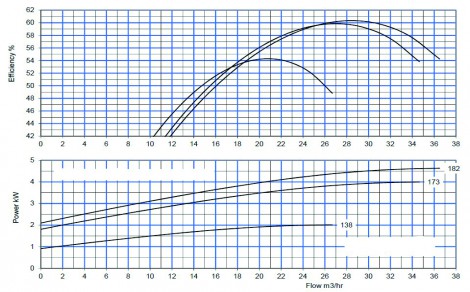- Home » Editorial » Hydraulics
Pump energy efficiency and risk mitigation

Ian Peel, technical manager, and Jason Butler, group commercial director, Pumptec Engineering, consider the benefits of adopting an ‘as new’ approach to pump maintenance and replacement.
Pause a while and think how many of your production processes require pumps to be available 24-7 in order to work. The efficient transportation of fluids is critical to most production sites, with the cost of energy, manufacturers must keep their pumps in near optimum performance in order to be efficient and reduce the risk of costly downtime related maintenance issues. While this starts with the selection criteria to ensure that the optimum pumping solution is provided, it must carry on as the plant evolves and the pumps wear.
The below article applies to all pump types but, for the purpose of illustration, follows the path of a baseplate mounted process pump as used in an industrial setting. As such, this article is not manufacturer-specific and is written from an independent expert point of view.
For a replacement pump the most obvious route is to look at the existing pump’s manufacturer and serial number to establish what is the most appropriate and nearest match. This is simple enough but only in the unlikely event that your plant and your processes have remained constant since the pump’s installation. Therefore, it is considered best practice to adopt a review akin to a new pump installation. To get the most out of a pump the following list of conditions of service should be considered and presented to the maintenance partner.
a. The pump’s role in the process: Is the duty cycle likely to be continuous or intermittent operation, and what are the suction conditions (i.e. always flooded or is it to work on a suction lift)? Most pumps work on flooded suction. There are, however, situations where the application dictates the pump must be self-priming; for example, removing process effluent from a sump or for loading and offloading tankers.
b. The liquid to be pumped: Is the liquid clean or are there solids present? If solids are present it is important to know the concentration, size and shape, (sharp or smooth) to determine the materials of construction and impeller design. For long-term reliability in a process with varying concentrations of an abrasive product, the materials of construction could range between hard metal, duplex stainless steel and 300 series stainless steel. Closed impellers are normally selected for handling clean or small solids or low % fibrous slurries, whereas a variety of open impeller designs are available for high viscosity liquids, low pressure pulse applications, high % concentration fibrous slurries, and liquids containing small and large solids of all shapes and sizes. Pumping temperature, SG or density and viscosity are key elements when deciding the best pump for the application. In some processes these can vary and that is why it is essential to have ‘maximum and/or minimum’ values as well as ‘normal’. Viscosity dictates pump type, where high values rule out a centrifugal pump making a positive displacement pump a better option

-
PPMA 2025
23 September, 2025, 9:30 - 25 September, 2025, 16:00
NEC, Birmingham UK -
Advanced Engineering Show 2025
29 October, 2025, 9:00 - 30 October, 2025, 16:00
NEC, Birmingham UK










